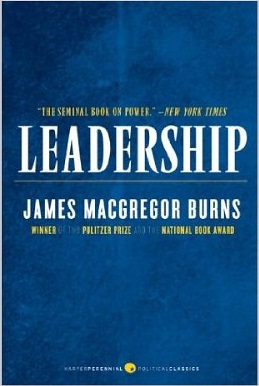 |
 |
Leadership | |||||
|
|
|||||||
|
Defining Leadership
How we define leadership betrays something of our underpinning assumptions about the role of leaders. For some, leadership is about setting goals, defining procedures and ensuring adherence (laying tracks, establishing timetables). For others it is about developing capacity within teams (providing maps and compasses).
It could be argued that different environments, cultures and organisations require different types of leadership. Hence, it would be inappropriate even to attempt a single definition of what it means to be a leader. This situational approach means that there is no single optimal set of characteristics of leadership. That is not to say that countless theorists have not attempted the task!
One thing that is apparent is that teams or groups of people working together almost always are more productive if they benefit from good leadership. Whether or not leaders are appointed or elected may also affect the role. Where tasks are given to groups from on high, leaders tend to be appointed and these are accountable to the authority that entrusted them with the task. Where a group generate their own tasks (sports clubs, trade unions, etc.), leaders tend to be elected and these are accountable to those who elected them.
|
|||||||
|
John Adair
|
|||||||
|
Adair (2003) maintains that working groups need a designated leader and starts by defining the key functions of a working group:
He asserts that these need not all be performed by the designated leader � but the designated leader does need to understand when each is required � and ensure that the group�s needs are met.
Adair (2003) suggests that there are three complementary paths to leadership
QUALITIES �In every field of human endeavour you can specify � or its practitioners can � five or six key qualities required in a good nurse, teacher, engineer, etc. These �local� qualities are what I call the typical ones, and together they form � or at least a �critical mass� of them form � a necessary condition for leadership.� (Adair, 2003, p.14)
SITUATION A person may be accepted as a leader �not so much on account of any inherent qualities of personality or character, but because of a person�s appropriateness to the given situation �. In other words, put a person in one situation and they will be accepted as leader; change the situation and they won�t.� (Adair 2003 p.31)
FUNCTION Managers are often appointed on the basis of their expertise and experience. They �do a good job� � therefore it �makes sense� that they should be appointed to lead the group. One might say that �Authority flows to the one who knows.� However, Adair (2003) maintains that although �you can be appointed a manager, � you are not a leader until your appointment has been ratified in the hearts and minds of those involved.� This would suggest that good leaders need more than merely expertise: they also need knowledge or understanding of human behaviour � how to encourage, enthuse and inspire others.
Adair suggests that the additional characteristics of leadership are:
(Adair 2003 p.17)
|
|||||||
|
Kurt Lewin |
|||||||
|
Kurt Lewin (1939) carried out research on groups of schoolchildren to ascertain the impact on performance of different styles of leadership. Lewin�s study was predicated upon three different leadership styles � Authoritarian (Autocratic) � Participative (Democratic) - Delegative (Laissez-faire).
AUTHORITARIAN (AUTOCRATIC) LEADERSHIP Authoritarian leaders lay down the law about what needs to be done, how it should be done and when it needs to be done. All decisions are made by the leader with little or no input from others in the workforce. The leader is seen as being �apart from� (outside) the group.
This kind of leadership can be justified in situations where there is little time for consultation or where the leader�s expertise is acknowledged as being key to the success of the group task.
Lewin found that this kind of decision-making was less creative and also suggested that there are difficulties in moving from an authoritarian style of leadership to a more democratic style.
This style of leadership can be perceived as �bossy� or even dictatorial.
Participative (Democratic) Leadership Although Participative Leaders still retain the right to make decisions, as well as offering guidance to the group, they encourage group members to contribute suggestions, points of view, etc. This means that group members are better motivated (because they feel some sense of �ownership� of the process) and are more likely to engage in the task � and to contribute creatively.
Groups under this style of leadership may take longer to �get started� (and hence may be less productive in the short term) but their creative input is more likely to produce work of a better quality.
Participative leaders are more likely to be seen as �part of� the group and Lewin suggested their style of leadership is generally the most effective.
Delegative (Laissez-Faire) Leadership Delegative leaders offer little or no guidance to group members, leaving them to make their own decisions. This may lead to the emergence of leaders from within the group (who then adopt their own particular style of leadership) but generally it leads to uncertainty about the group�s purpose and direction. This results in a lack of motivation and potential conflict.
Lewin�s research found that children under this kind of leadership were the least productive of all three groups. However, it should be noted that Lewin�s research was carried out on groups of children � whereas it may have yielded different results if it had been carried out with adult participants. For instance, the Delegative leadership style may be more likely to produce results when applied to a group who have developed a degree of expertise in their skill area and confidence in their own abilities. Such a group may be more prepared to make decisions and take responsibility for their actions.
Delegative leaders can also be seen as �apart from� the group. |
|||||||
|
One would hope that it is now generally accepted that the wise leader will consult and consider the input of others. Adair (2003) maintains it is a principle that �the more a person or group shares a decision that affects their working life, the more they are motivated to carry it out.�
Tom Peters, �management guru�, advises leaders to �stay away from your desk as much as you possibly can, and keep in touch with your staff.� (Heller, 2000, p.43) He actively encourages managers to maintain contact with the workforce, maintaining that they are often the greatest underused resource of any organisation. It is part of a wider strategy that seeks to �tear down cultures of bureaucracy, interference and lack of autonomy� (ibid. p.27) in a bid to maximise the creativity and effectiveness of the workforce. Peters maintains that rigid management militates against experiment, and that successful organisations need to create and maintain a culture wherein it is OK to try out new ways of doing things. |
|||||||
Management and LeadershipAlthough �management� and �leadership� are often confused (or used synonymously), there is much debate about whether they are two different animals. Burns (1978) makes a distinction between �transactional� and �transformational� leadership. The former is characterised by an emphasis on procedures, compliance, rules and rewards: the latter by relationships and personal development, innovation and creativity.
Fiedler�s (1967) Contingency Model defines two types of leader: those who are task-oriented and those who are people-focused. (This bears comparison with the Product/Process dichotomy within educational theory.) According to Fiedler, both of these approaches can be effective if they are appropriate to the situation. It is perhaps too easy to suggest that these two approaches epitomise the difference between management and leadership. Nevertheless, Adair maintains that things (machines, money, time, working environment) can be managed � but people need to be led. (Adair, 2003, p.68) Furthermore, he would maintain that people need to be inspired and that the best way to inspire people for the work in hand is to be inspired yourself.
It is widely acknowledged that workforce behaviour and productivity is affected by emotional states. Because leaders create the situations and events within the workplace that elicit an emotional response, it is important that leaders are aware of the emotional impact of their decision making; a factor which should influence the level of participation that they encourage and the way in which decisions are communicated. (See Emotional Intelligence) |
|||||||
|
Neo-emergent leadership - and "spin" The Oxford school of leadership has suggested that leadership is a matter of perception based upon the way in which the actions of the leader are presented. This Neo-emergent leadership theory proposes that the �stories� that grow around a leader (generated by the leader, his close disciples, or a broader band of followers) create the �style� that is attributed to the leader. It could be argued that this �spin� (as it has become known colloquially) does not reflect the true qualities of the leader but merely how they (or their entourage) would prefer them to be perceived.
Before cynically dismissing this suggestion, it is worth remembering that "stories and myths" can play a big part in establishing organisational culture, which in its turn impacts upon the motivation and performance of the workforce.
|
|||||||
|
References:
Adair, J. (2003) The Inspirational Leader. London; Kogan-Page
Burns, J. M. (1978). Leadership. New York; Harper and Row Publishers Inc.
Lewin, K., Lippitt, R., White, R. (1939). "Patterns of aggressive behavior in experimentally created social climates". Journal of Social Psychology: 271�301.
Fiedler, F. (1967). A theory of leadership effectiveness. New York; McGraw-Hill.
Heller, R. (2000) Tom Peters. London; Dorling Kindersley
|
|||||||
 |
 |
 |
 |
||||
|
The Inspirational Leader
John Adair
|
Leadership
J M Burns
|
A Theory of Leadership Effectiveness
F Fiedler
|
Tom Peters
Robert Heller
|
|
|||
|
Useful websites
Leadership styles questionnaire
|
|||||||